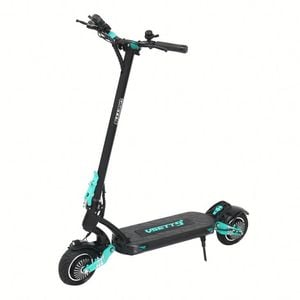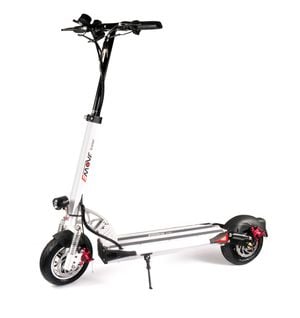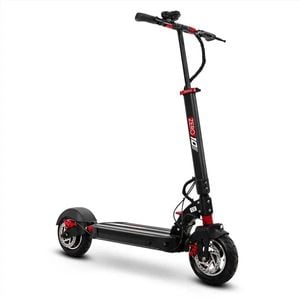Zero 10 Review
31 mph
Speed
33 miles
Range
52 lbs
Weight
The Zero 10 is the middle child of the Zero range. Not quite a commuter scooter and not quite a fully-fledged performance ride, either, it will suit riders looking to take the step up from a slower, more conventional scooter. That’s not to say the Zero 10 doesn’t have some stellar features, though. With customizable handlebar height and foldable handlebars, it’s plenty portable – and its optional seat attachment and LED lights are sure to win many admirers.
$1,399.00
*Offers displayed are from retailers that we trust. If only one offer is available this is because they are the only retailer we recommend. To support our rigorous scooter review and editorial process, we rely on affiliate commissions. These are at no cost to you. Our work is independent and impartial. Read more here.
Zero 10 Review: 10 Things You Need to Know
Who is it Best For?
Will the Zero 10 Be a Good Fit For You?
The Zero 10 is a scooter with a bit of an identity crisis.
Essentially, it’s simply a souped-up version of the Zero 9. Yet, while the 10 improves on the speed and range of its predecessor, its increased weight makes it not as well-suited to commuting as its little bro. Similarly, anyone looking for better speed, acceleration, or features can simply pay $300 more for the Zero 10X, or look at our recommended Zero 10 alternatives, including the VSETT 9+R and Mantis Base.
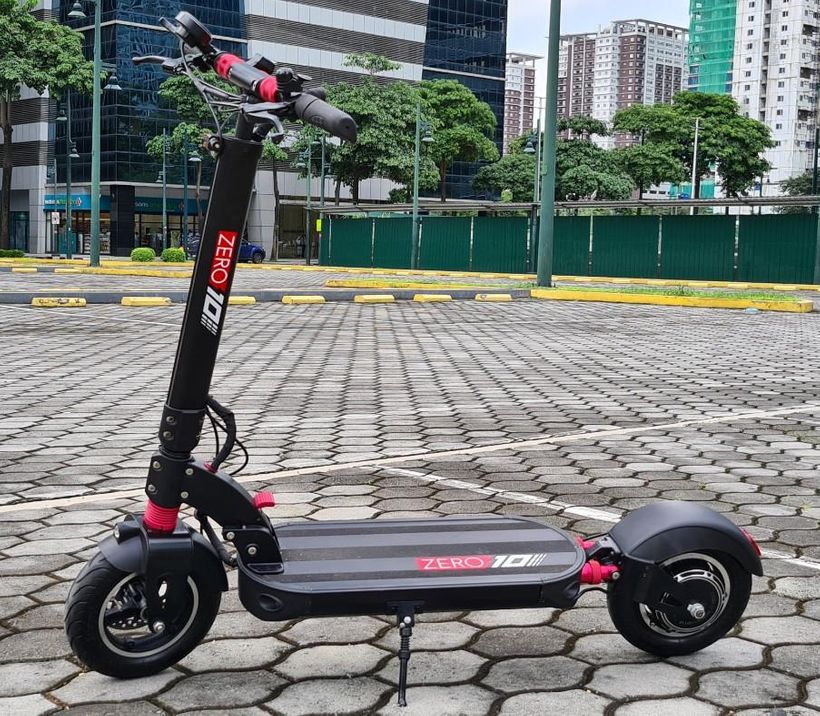
With that in mind, there isn’t a huge array of riders I’d recommend the Zero 10 to. At 52 lbs, it’s too heavy for commuters. At 31 mph, it’s too slow for speed freaks. And, at $1,399, it’s too expensive for bargain-hunters – particularly when the fantastic EMOVE Cruiser is available for the same price.
The Zero 10 isn’t well-equipped to handle rough riding, either – although it can cope with most urban terrain, and some light forest or hard-packed dirt paths.
If I had to recommend the Zero 10 to anyone, it’d be those with an existing affinity for the Zero line. If you’ve previously owned the Zero 8 or 9, liked them, and want to upgrade – but aren’t quite ready for the sizzling specs of the 10X or 11X – the 10 could be an inviting middle ground. Similarly, the Zero 10 can serve as a good bridge between slower, commuter brands like GoTrax and Segway-Ninebot, and the more intense high-performance scooter models on the market, such as the VSETT 10+R.
Pros and Cons
- Telescopic stem lets you adjust the height of the handlebars
- 10 inch pneumatic tires and spring suspension soak up undulations
- Striking LED strip lighting
- Powerful disc brakes
- Foldable frame and handlebars
- Good build quality and design
- Optional seat attachment
- No water-resistance rating
- Headlight is poorly-positioned and insufficiently bright
- Its single motor means it struggles for speed, acceleration, and hill-climbing
- No kickplate, horn, or turn signals
Value for Money
Is the Price Tag Worth it?
To be frank, the answer to this question is no – the Zero 10 isn’t good bang for your buck. It’s a fine scooter, sure – it looks nice, and the specs are a good step up from the kind of conventional commuter scooters that limit your top speed and range.
But compare it to what else is on offer for a similar amount of money, and the Zero 10 pales considerably. And, to illustrate exactly why that is, I’m going to let you in on a little secret.
In my review of the Zero 9 – which is kind of a down-sized version of the 10 – I talked about how that scooter (in terms of build, at least) is more or less the identical twin of the Apollo City. Both of those scooters – as a result of being made by prominent scooter manufacturers Titan/Unicool – have the same frame. Zero and Apollo then kit the frames out with their colors and logos and also add the battery of their choice. The result? Two almost identical scooters.
The thing is, this is the same situation with the Zero 10 and the Apollo Explore.
Look closely, and you’ll see that the two scooters are built the same: 1000W single motors, 52 lbs of weight, and the same brakes, tires, top speed, and load-bearing capacity. At $1,399, they even sport the same price tag.
Yet not all scooters are created equal – not even these two.
Because look closer, and some key differences start to emerge – and it’s not good news for the Zero 10. The Apollo Explore has a better battery thanks to its Dynavolt cells that offer a longer lifespan than the 10’s cheaper Chinese cells. Because of this, the Apollo Explore can hold its peak performance for longer than the 10. Moreover, the Explore totes an IP54 water-resistance rating, meaning that – unlike the Zero 10 – it can withstand rainy conditions.
Take a look at how the two scooters compare in the chart below:
| Specs | Zero 10 | Apollo Explore |
|---|---|---|
| Motors | 52V 1000W | 52V 1000W |
| Battery | 48V 18.2Ah Chinese Cells | 52V 18.2Ah Dynavolt Cells |
| Range | 33 miles | 34 miles |
| Top Speed | 31 mph | 31 mph |
| Load | 265 lbs | 265 lbs |
| Weight | 52 lbs | 52 lbs |
| Brakes | Front & Rear Discs | Front & Rear Discs |
| Tires | 10 inch (Air-Filled) | 10 inch (Air-Filled) |
| Water-Resistance | None | IP54 |
| Price | $1,399 | $1,399 |
Alternatives
What Other Scooters Should You Consider?
Mantis Base
- Speed: 40 mph
- Range: 30 miles
- Weight: 65 lbs
- Load: 265 lbs
Why is it Better Than the Zero 10?
- Faster (+9 mph)
- Dual motors 60V 1000W motors (vs single 52V 1000W)
- Faster acceleration rate (it’s 46% faster to 25 mph)
- Better hill climber
- Sports a kick plate, which allows you to lean into the ride at higher speeds
Why is it Worse Than the Zero 10?
- Costs more (+$250)
- Heavier (+9 lbs)
- No headlight
Price:
-
1,649.00
$1,699.00
VSETT 9+R
- Speed: 33 mph
- Range: 40 miles
- Weight: 55 lbs
- Load: 265 lbs
Why is it Better Than the Zero 10?
- Dual 48V 650W motors (vs single 52V 1000W)
- 34% faster acceleration
- Longer range (+7 miles)
- Adjustable suspension provides a more comfortable ride
- Triple stem locking mechanism means it’s less susceptible to stem wobble
- Sports a water-resistance rating (IP54)
- Boasts turn signals and a horn
- Comes with a neat NFC key-lock immobilizer to deter sticky fingers
- Has a kick plate for extra traction and control
Why is it Worse Than the Zero 10?
- Cost more (+$350)
- Heavier (+3 lbs)
- No mood deck LEDs or swag lighting
Price:
- 1,749.00
EMOVE Cruiser
- Speed: 30 mph
- Range: 62 miles
- Weight: 52 lbs
- Load: 352 lbs
Why is it Better Than the Zero 10?
- 88% more range (+29 miles)
- Supports heavier riders (+87 lbs)
- Superior semi-hydraulic disc brakes
- IPX6 water-resistance rating
- Available in five different colors
- Sports turn signals and an anti-theft key-ignition feature
- Brighter headlight
Why is it Worse Than the Zero 10?
- Lacks the swag lighting of the Zero 10
Price:
- 1,399.00
Design
Handlebars
Okay, so the handlebars aren’t particularly wide or built in a curved shape for comfort. However, they do offer one of the most intuitive, reliable folding mechanisms I’ve seen – particularly on scooters in that coveted $1,000 to $1,500 price range.
The Zero 10’s handlebars collapse inward easily – making the scooter easier to store and move around – and, although they require tightening now and then, when they are locked into place they aren’t prone to wobble or instability.
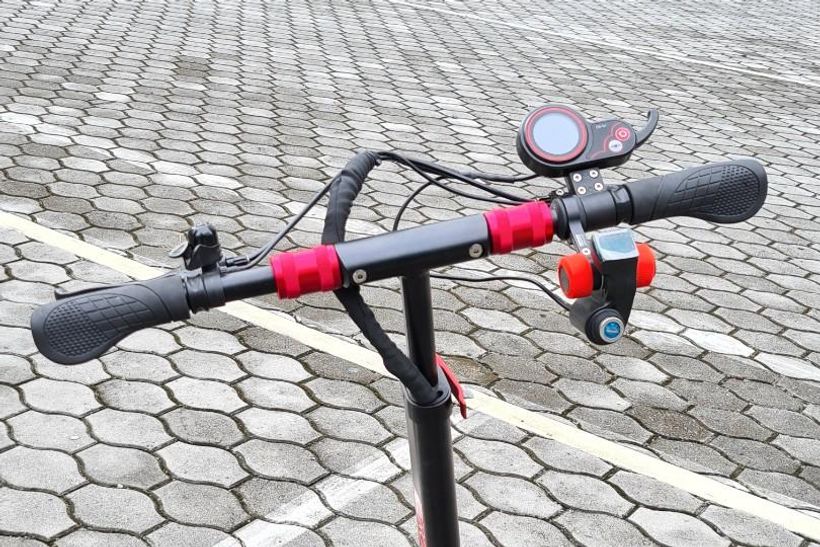
Mounted on the handlebars, you’ll find the QS-S4. This is a device that doubles as both your finger throttle and a screen for displaying your riding mode and stats and even has a hidden USB port tucked away behind its dial. There are precious few other contraptions you’ll have to get to grips with on the Zero 10’s handlebars – just its pair of hand-operated mechanical disc brakes.
Coating the ends of the Zero 10’s handlebars are rubber grips. These are ergonomically shaped to provide comfort on long rides and are far superior to the cheaper grips we see on some similar scooters, like the Kugoo G2 Pro.
Frame
Though the specs, features, and power of the different models in the Zero line differ, one constant is the colors that they’re all decked out with. Like the 8 and 9 before it – and the 10X and 11X after it – the Zero 10 keeps things simple with fringes of red complimenting a predominantly midnight black color scheme.
The frame – while it doesn’t quite match the 11x’s dual tubular stems for badassery – does still channel a strong vibe. With exposed, bunched cabling popping from the top and bottom of the stem, and a set of chubby tires, the Zero 10 means business. Thankfully, the branding – which is limited pretty much solely to a set of small logos on the stem and deck – is kept to a minimum, so it’s not as in-your-face as that of others.
Oh, and no discussion of the Zero 10’s frame would be complete without at least paying lip service to the stunning set of LED strips lining the underside of its deck and front of its stem – but more on that later.
Deck
As explained earlier, the Zero 10 is essentially a souped-up version of the Zero 9 – so it’s only fitting that, at 21 x 9 inches, the 10’s deck expands on its predecessor by 1.5 inches in length and 1.3 inches in width. That makes it plenty large enough for you to stand comfortably, although the lack of a kickplate at the rear of the deck does restrict your full range of movement.
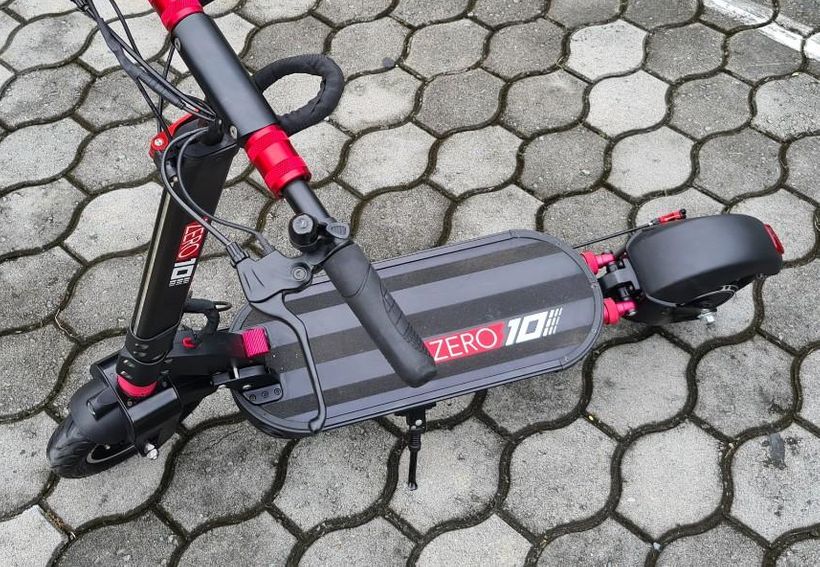
Kickplates are small panels – usually positioned over the rear wheel, towards the tail end of the deck – that serve as rests for your back foot. These platforms allow you to lean into the ride, and afford more traction and control when traveling at higher speeds. While the Zero 10 has a rear fender, this is geared more towards stopping mud splashes, rather than as a place for your foot. It’s also made from plastic, so I don’t recommend putting any weight on it.
Talking traction, the Zero 10’s deck relies on three thin strips of grip tape. While this means that less surface area is covered, they’re perfectly adequate. By comparison, the Apollo Explore sports a geometrical cutout grip tape design that covers the entirety of the deck.
Inside the Zero 10’s deck is where you’ll find its battery, and on either side, you’ll find two strips of stylish LEDs. But more on that in the ‘Extra Features’ section of the review.
Wheels
The Zero 10 sports a pair of 10 inch pneumatic tires. Made with a design that prioritizes comfort, these – along with the front and rear spring suspension – help safeguard your joints from vibrations caused by tricky terrain.
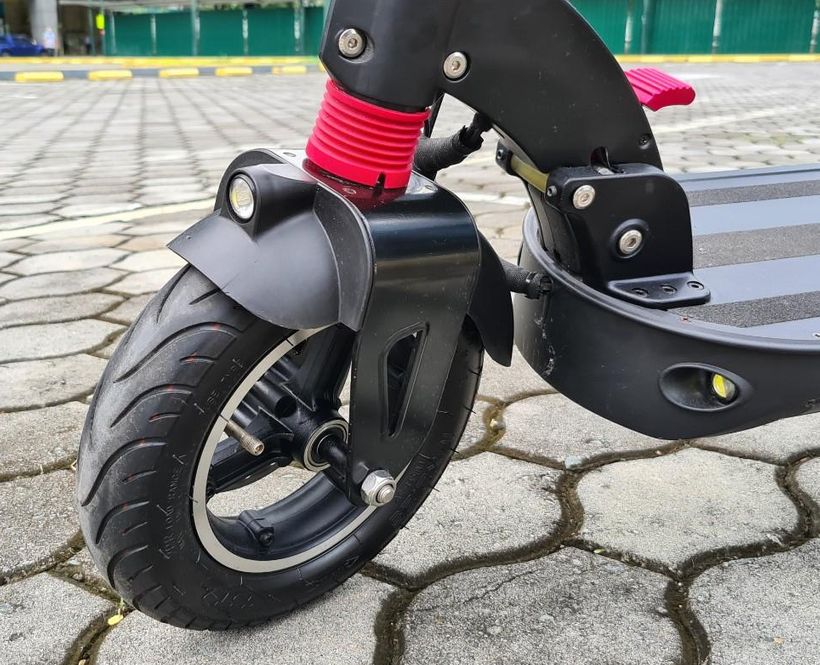
Sure, the pneumatic tires are more prone to punctures than their solid counterparts, but you can always add a licking of tire slime to their interior to protect against this. For the extra comfort they provide, they are irreplaceable.
Another benefit the tires offer is in their size. Larger tires provide you with a greater contact patch with the road, giving you better handling and control over the scooter. At 10 inches, they are the second-biggest in the Zero line – and have the most common size profile among scooters of the 10’s ilk. Take a look at how they stack up against the rest of the Zero range below:
| Scooter | Tire Size | Tire Type |
|---|---|---|
| Zero 8 | 8.5 inches | 1 x Pneumatic, 1 x Solid |
| Zero 9 | 8.5 inches | 2 x Pneumatic |
| Zero 10 | 10 inches | 2 x Pneumatic |
| Zero 10X | 10 inches | 2 x Pneumatic |
| Zero 11X | 11 inches | 2 x Pneumatic |
For a deeper dive into how the Zero 10’s wheels work to provide a decently comfortable ride, jump to the ‘Shock Absorption & Suspension’ section of the review.
Build Quality & Durability
The frame is composed of a precipitation-hardened aluminum called 6061 T1 – an alloy known for its light weight and heavy durability.
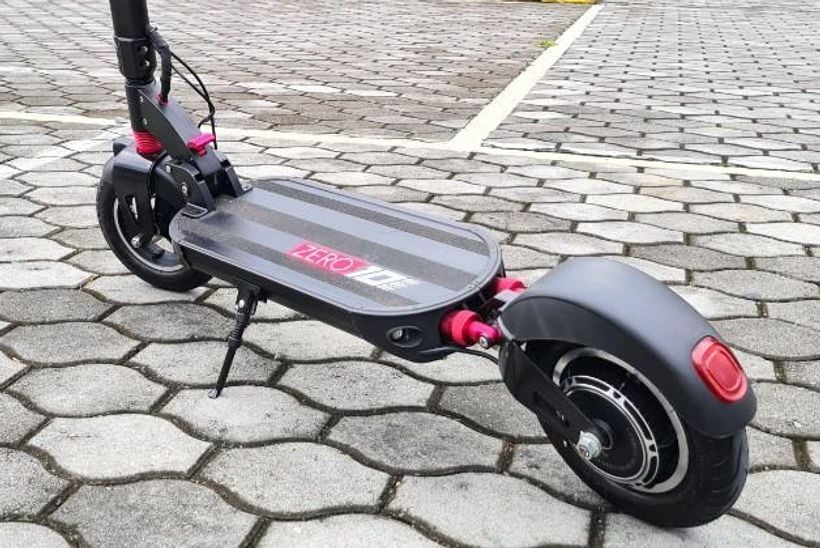
And the rest of the frame follows suit, with a pair of hard-wearing, high-quality tires, robust spring suspension at the scooter’s front and rear, and a silently purring single motor.
The battery is could be better and this would make the scooter more reliable. It would have been nice to see the Zero 10 take a leaf out of Apollo Explore’s book, and fit its battery with Dynavolt (or LG) cells, rather than the cheaper Chinese variety. I’d also like the Zero 10 to have a water-resistance certification – like the EMOVE Cruiser’s IPX6 or the Explore’s IP54 – so you could ride it in the rain.
Overall, the Zero 10 is a well-built scooter, but not great by any stretch.
Weight & Load
The Zero 10 weighs 52 lbs, which is about what you’d expect for a scooter of its size and specs.
For context, that’s the same weight as the EMOVE Cruiser and Apollo Explore, but a whole 12 lbs heavier than its little bro, the Zero 9 – although the 9 is considerably slower, and has a much more limited range.
Unfortunately, though, by my standards, the bulk also makes it 10 lbs too heavy to be considered a commuter scooter, and it’s not particularly fit for life being dragged on and off buses or trains, or up and down flights of stairs.
Load-wise, the Zero 10 supports 265 lbs of rider weight – also pretty standard for scooters in its niche. If you need more support, the similarly-priced EMOVE Cruiser can handle up to 352 lbs of rider weight and ranks second for load-bearing in our database of over 100 scooters. The only ride to support more is the 400 lbs of the $2,999-priced Wolf King.
Folding & Portability
As I just mentioned, the Zero 10 is no commuter scooter – but that doesn’t mean it isn’t portable. It sports several nifty features to help you tuck it away into the trunk of a car or a closet.
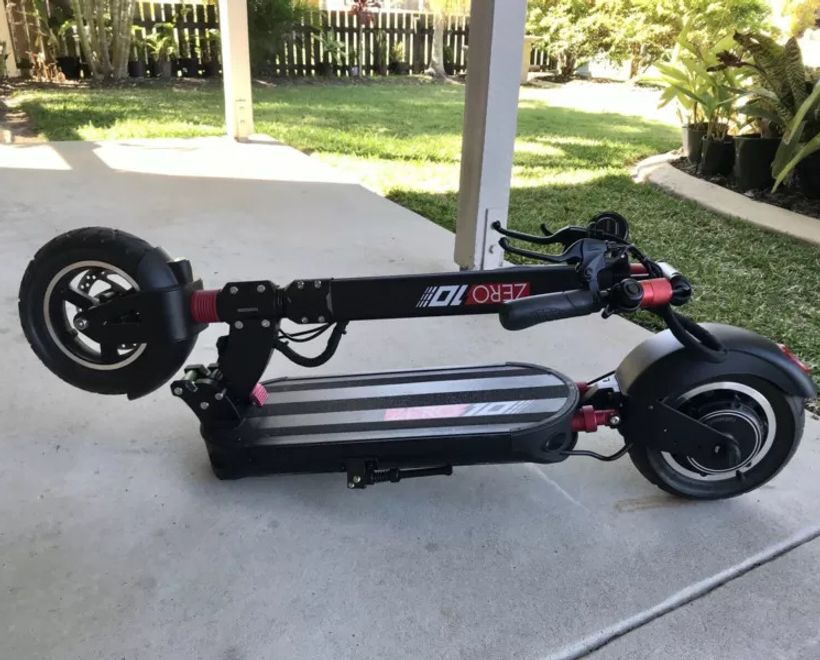
For one, its handlebars fold. Twisting the pair of locking sleeves – then sliding them outward – will release the grips, and allow the handlebars to collapse inward.
Plus, the sleeves are superior to those we see on popular Zero 10 alternatives, such as the EMOVE Cruiser. Because of its combined tension and screw design, there’s little of the unnerving wiggle you get with other foldable handlebars, like the Cruiser’s spring-loaded tension cuffs. You’ll still have to tighten the Zero 10’s handlebars’ locking sleeves (they’ll tend to loosen up over time due to the vibrations from riding), but this is no big deal.
Folding the Zero 10 in half is just as easy. There’s a small anodized tab at the base of the stem, which – when you push it down – unlocks the scooter’s steering column from the neck. Then, it’s simply a case of folding the stem down until it clicks into place.
Finally, the telescopic stem helps when it comes to portability. This feature is oriented chiefly towards giving you more control over how high your handlebars are, but the semi-retractable stem – which shrinks down to a minimum height of 29 inches – comes in handy when it comes to packing this scooter away, or preparing it for transit.
A Guide to Foldable Electric Scooters (Lightest & Most Compact)
Assembly
The Zero 10 doesn’t require a huge amount of assembly. It arrives pretty much fully assembled, with the only task coming in the form of tightening the brake levers and QS-S4 display into place. Tip: we recommend positioning the brake levers at a downward angle to make them easier to use.
Before you hit the road, I’d recommend ensuring your new ride is fully charged, and double-checking the pressure in the tires. If you’re going to be riding at night, you’ll need to strap on an extra headlight, too. It’s also worth taking the time to check the settings in the QS-S4 display.
Ride Quality
Is the Zero 10 Comfortable to Ride?
In short, yes – the Zero 10 is a pleasure to ride. By taking one of the best features of the Zero 9 – its pneumatic tires – and super-sizing them to the 10 inch rubber monstrosities we see on the likes of higher performance models like the Mantis or the superb VSETT 10+R, the Zero 10 makes its commitment to ride experience crystal clear.
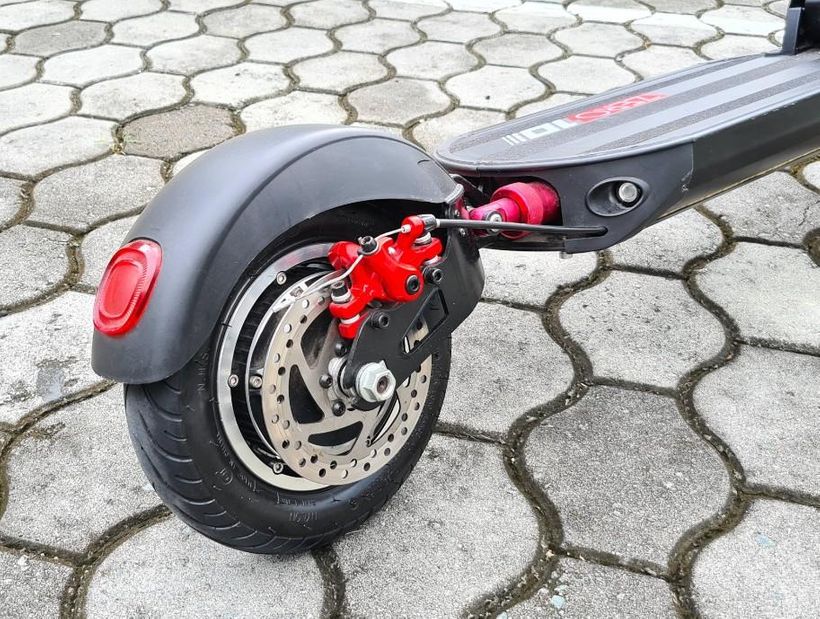
Supporting the chunky tires – that are well-equipped as the first shield of defense against jarring vibrations – are both front and rear spring suspension. With the front shock absorber handling the initial impact and the rear dual springs smoothing out the ricocheting vibrations, the suspension is fairly good. However, this is only true for urban terrain. The suspension system doesn’t have enough travel for it to cope with environments that present challenges, like potholes and for that matter, off-road routes.
In terms of how this compares to the Zero 10’s alternatives, the Mantis Base and VSETT 9+R both offer better ride quality due to their superior swingarm suspension systems. Swingarms up the ante in terms of both compression and damping to provide smoother transitions. Because of this, both scooters can handle light off-road terrain.
The EMOVE Cruiser, on the other hand, has a better riding setup than the Zero 10 with its larger dual springs in the front but it too can only truly cope with urban environments.
Performance & Safety
Speed & Acceleration
The Zero 10 sports a top speed of 31 mph.
That’s a full 7 mph faster than its little brother, the Zero 9, although – with an extra $300 bloating the 10’s price tag – that superiority is to be expected. Instead, the real question is not how the Zero 10’s top speed stacks up against its fellow Zero models, but how it measures up to the most analogous scooters in its price and weight classes. So let’s take a look.
Speed vs Price Comparison
Applying a $500 price range centering around the Zero 10’s $1,399 price tag provides 22 similarly-priced alternatives. Among these, the Zero 10 sits just above the middle of the pack, alongside the Apollo Explore and EVOLV Tour XL-R.
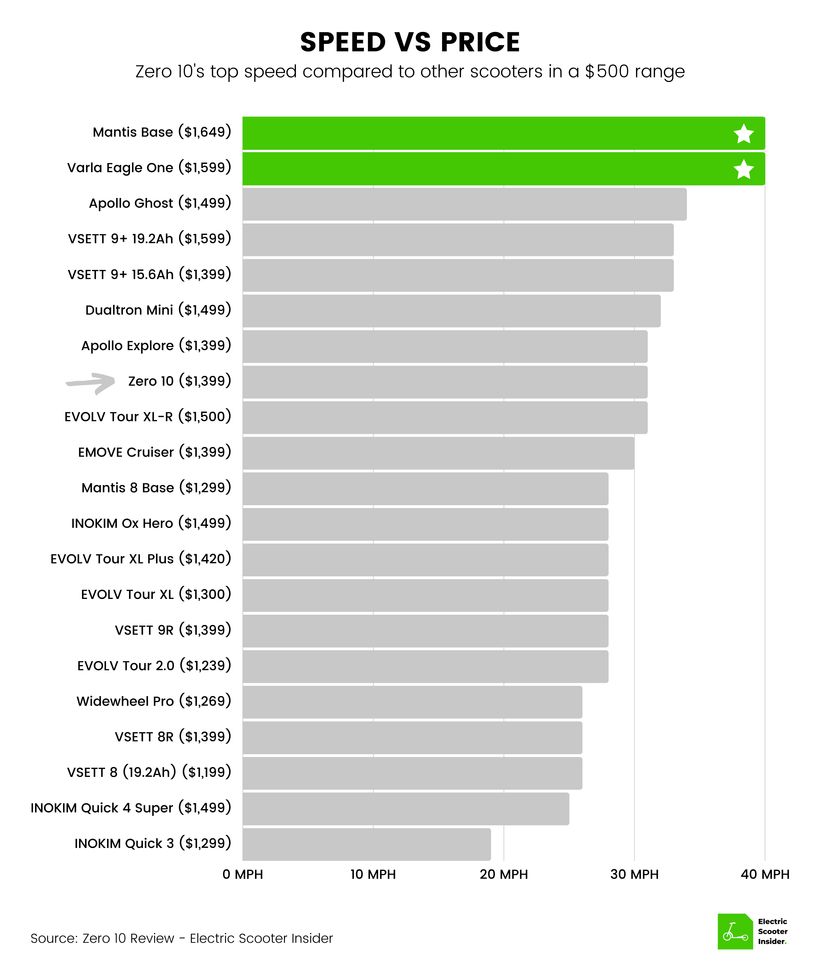
This indicates that the Zero 10 doesn’t offer as much speed as its competitors for the money you’re paying, and there’s one major culprit – the scooter’s lack of dual motors. Dual-motor equipped models dominate the higher rankings, and the Zero 10’s single 1000W motor – while still a pretty powerful engine – simply can’t match the pace and acceleration offered by the likes of the Mantis Base, Varla Eagle One, and the VSETT 9+ range.
Sharing the summit of these rankings are the 40 mph speeds of the Mantis Base and the Varla Eagle One. If you’re after a scooter with a high-speed pedigree, both are great options, but I prefer the Mantis.
This popular scooter – which you can read about in more detail in my Mantis review – doubles up on the Zero 10’s 1000W motor, which endows it with more speed and superior hill-climbing capabilities. Better still, it operates at 60V, upping the ante of the 10’s 52V to pull more power to the motors and offer increased torque and acceleration accordingly. This allows the Mantis Base to hit a top speed that’s almost a third (29%) faster than what the Zero 10 is capable of. It also accelerates to 25 mph 46% quicker (5.2 vs 9.6 seconds).
Alternatively, if you’re happy to stick with a top speed that’s around the same mark as the Zero 10 – but enjoy a much faster acceleration rate – the Apollo Ghost is a super option. It’s only 3 mph faster than the 10 but can hit 25 mph in 5.3 seconds. That’s just a split second slower than the aforementioned Mantis Base, but a whopping 4.3 seconds quicker than the Zero 10’s 9.6 seconds.
Perhaps the only caveat to these speedy alternatives is their price tags. Compared to the 10, you’ll have to pay $100 more for the Apollo Ghost, $200 more for the Varla Eagle One, and a hefty $250 extra for the Mantis Base. But if these are beyond your means, don’t fret – the VSETT 9+ (15.6Ah) is a great option. As well as providing a superior acceleration thanks to its dual 650W motors, the 9+ (15.6Ah) is available for $1,399.
Speed vs Weight Comparison
Taking a similar formula as we did with the pricing bracket above, let’s compare the Zero 10 to the 15 comparable models in its weight class of 47 to 57 lbs (that’s 5 lbs either side of its 52 lb bulk).
This time, the Zero 10 performs a little better. The scooter snatches a podium position with a joint third place, tying with the Apollo Explore and EVOLV Tour XL-R.
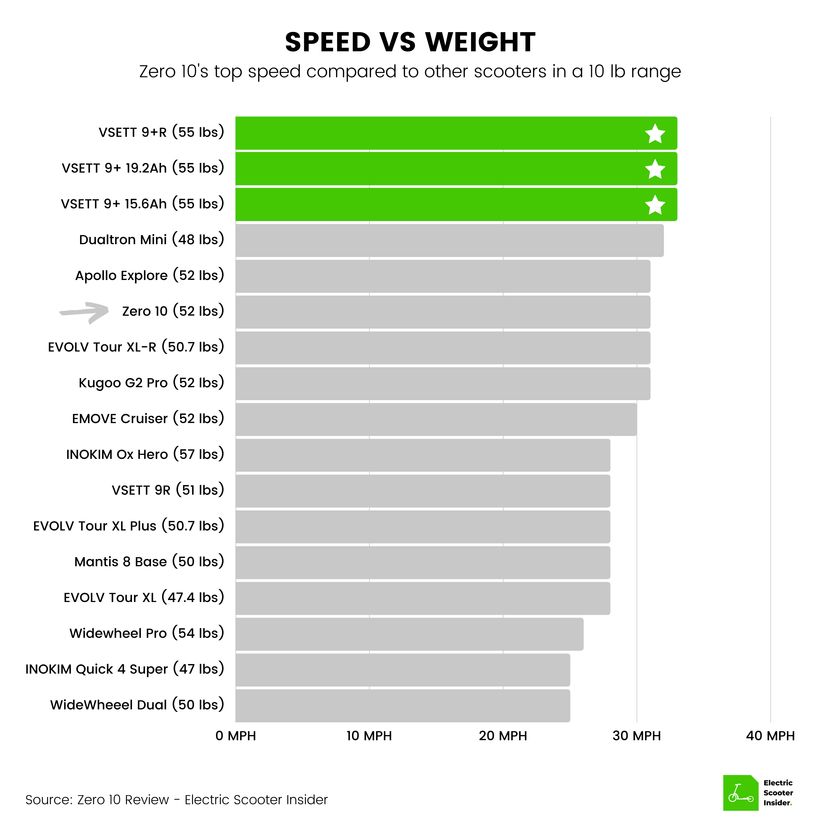
Edging towards the upper tier of our rankings is the Dualtron Mini in second place, with the entire VSETT 9+ lineup laying claim to gold. By and large, this is down to their dual 650W motors, which give them a top speed of 33 mph – 2 mph quicker than the Zero 10.
If your budget can stretch, these popular VSETT models are worth the extra outlay. Sure, that 33 mph of speed may not seem like a big jump compared to the Zero 10’s 31 mph. But the VSETT models’ greatest strengths lie not necessarily in their top speeds, but in how fast they’re able to accelerate. The VSETT 9+R, for instance, is capable of reaching 25 mph in just 5.4 seconds – a whole 4.2 seconds (or 44%) quicker than the Zero 10. It’s also worth noting that the VSETT range was originally intended to be the Pro line of the Zero scooters.
If you’re not so much of a speed freak, though – and aren’t intent on harnessing the adrenaline-pumping action that only dual-motor scooters can provide – I recommend the EMOVE Cruiser over the Zero 10. Speed-wise, it pretty much matches the Zero 10 pace-for-pace, but – courtesy of its superior build quality and larger battery – it outperforms the Zero in every other way.
Acceleration
Scooters lacking dual motors tend not to be the greatest accelerators, and while the Zero 10 is no slouch it fails to compete with the rapid acceleration rates of the scooters I recommend as alternatives. Dive into the table below to compare.
| Scooter | 0-15 MPH (Seconds) | 0-25 MPH (Seconds) |
|---|---|---|
| Mantis Base ($1,649) | 2.5 | 5.2 |
| VSETT 9+R ($1,749) | 2.7 | 5.4 |
| EMOVE Cruiser ($1,399) | 3.4 | 11.0 |
| Zero 10 ($1,399) | 3.5 | 9.6 |
As you can see, the Zero 10’s acceleration rate to 15 mph pales to all three of its closest competitors, while – to 25 mph – it beats out only the EMOVE Cruiser. Again, this comes down to the issue of the Zero 10’s single motor, which isn’t able to compete with the rapid acceleration rates of dual-motor aficionados, like the Mantis Base (which, at 5.2 seconds, is 46% quicker to 25 mph than the Zero 10).
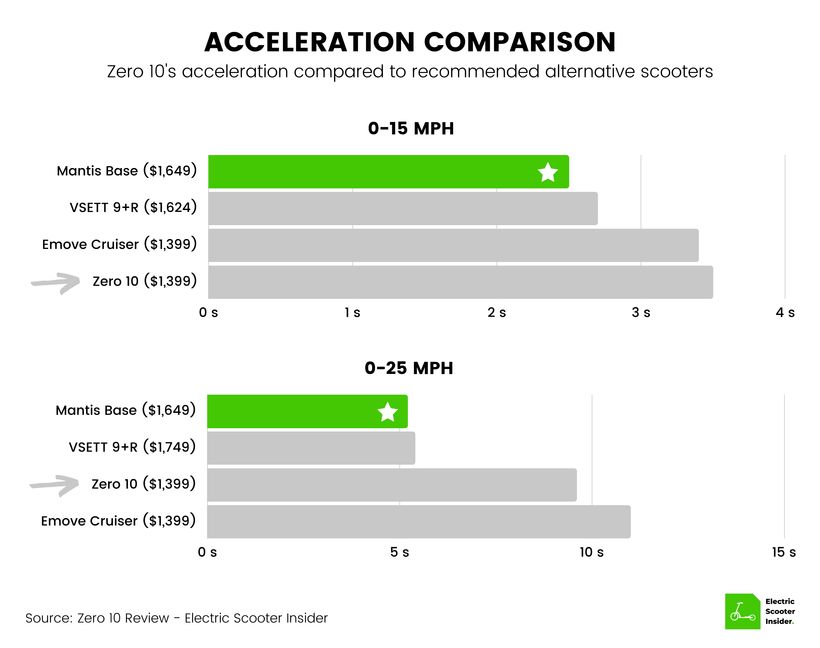
If you can stretch your budget by an extra $250, I recommend doing so to get your hands on the Mantis Base. It boasts one of the fastest acceleration rates in our database of over 100 scooters, with the Base’s only drawback coming in the form of its weight – which, at 61 lbs, is a whole 9 lbs heavier than the Zero 10. The Mantis Base also lacks all of the portability benefits of the Zero 10, including its telescopic stem and foldable handlebars.
Ultimately, the best package has to be the VSETT 9+R. With dual motors and one of the quickest acceleration rates – not to mention foldable handlebars – it offers the best of both worlds. Plus, it’s only 3 lbs heavier than the Zero 10 (though it costs more).
Alternatively, the EMOVE Cruiser is a great option if you want all the portability and speed of the Zero 10, but with a colossal 62 mile range. The Cruiser is a game-changer if distance – rather than dizzying pace – is more important to you. Considering it’s available for the same price as the Zero 10, it’s an absolute steal.
Range
The Zero 10 is capable of hitting a manufacturer-stated range of 33 miles off a single charge – though that will, of course, depend on how hard you’re pushing it, as well as factors such as your weight, and the riding mode you’ve selected.
Realistically, you can expect 22 miles.
Mileage vs Price Comparison
Of the 21 other models in the Zero 10’s price range ($1,149 to $1,649), the 10 emerges in almost the dead center of the pack. That means that, while the 33 mile range aligns with the overall average mileage of the bunch, it’s certainly not winning any awards. And once more, its ranking indicates that – if range is your top priority – there are similarly-priced alternatives to the Zero 10 that offer far better bang for your buck.
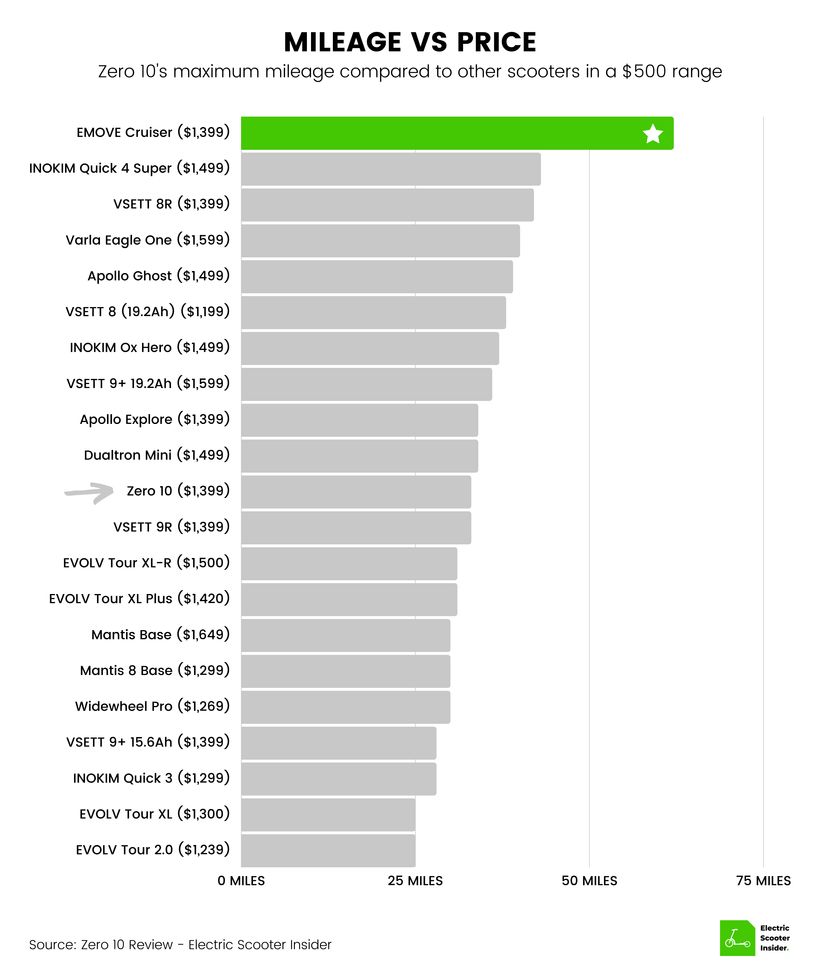
The scooter that provides the most value for money in terms of range is, predictably, the EMOVE Cruiser. There are many parallels between the Zero 10 and the Cruiser – they share an almost identical speed, sport the same single 52V 1000W motor, and cost the same. With all that in mind, you could be forgiven for guessing that their ranges were similar, too – but there, you’d be wrong.
The Cruiser delivers an insane 88% more range (29 more miles of it, to be exact) than the Zero 10. It also flaunts superior semi-hydraulic disc brakes, turn signals, and a brighter headlight. It’s better equipped to deliver a comfortable ride, too, and comes with an IPX6 water-resistance rating – plus your choice of five groovy colors.
If you have money on your mind, though – and want more mileage for less outlay – the VSETT 8R will be up your street. The 8R backs up its impressive 42 mile range with a whole host of advanced features, while its adjustable spring and swingarm suspension make it a supremely comfortable ride to boot.
It’s also worth adding that both the 8R and the aforementioned EMOVE Cruiser come equipped with better quality LG batteries than the Zero 10’s cheaper Chinese cells. The latter tend to deteriorate quicker than their LG counterparts, which affects the longevity of your ride. With all this in mind, both the Cruiser and the 8R present themselves as superior selections.
Mileage vs Weight Comparison
Just as it did in our mileage vs price comparison, the Zero 10’s range sits close to the overall average when compared to the 15 other scooters in its weight division (47 to 57 lbs). And yet again, the Zero 10 offers an underwhelming mid-table placing, with the EMOVE Cruiser’s epic 62-mile range comprehensively stealing the show.
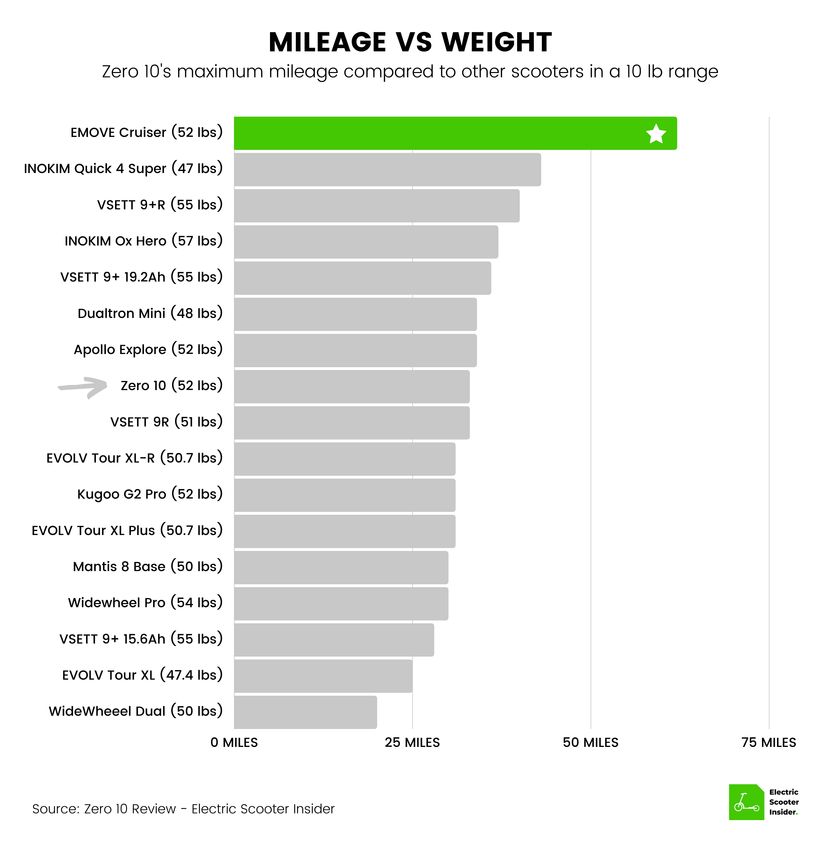
The INOKIM Quick 4 Super follows closely behind, but its single 600W motor (which saddles it with a sluggish top speed and acceleration rate) means that I can’t recommend it as a good all-rounder. That makes the next best option the VSETT 9+R. This scooter combines a fast acceleration rate with a mileage that’s almost one-third (31%) greater than that offered by the Zero 10, and its superior build quality make it the more reliable option across the board.
Hill Climbing
The Zero 10’s single 52V 1000W motor means it can handle most of the urban slopes that you’re able to throw at it. However, you can expect any gradients towards the upper limit of the 20-degree incline rate to force the scooter into a crawl.
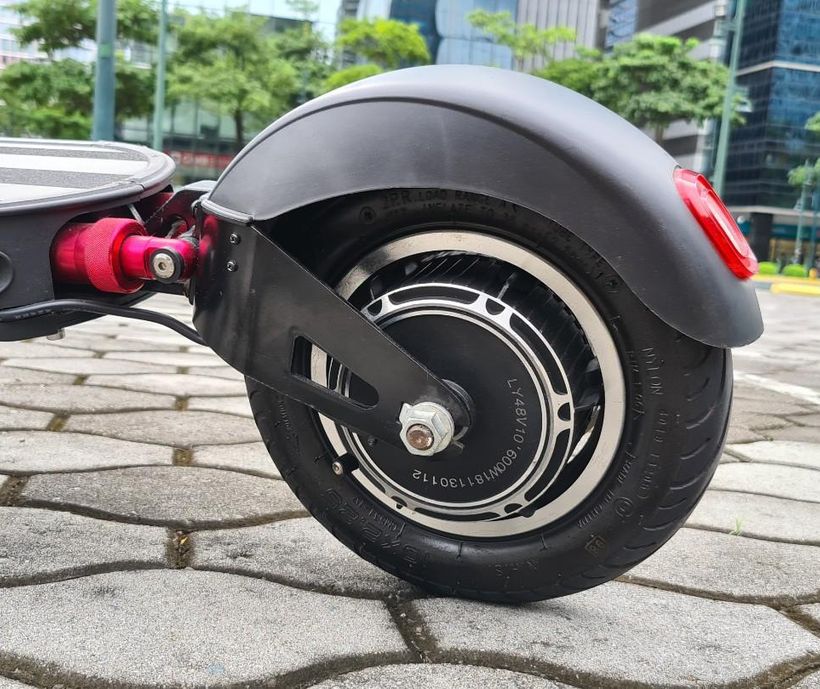
For a pair of excellent hill-climbing scooters that are (more or less) in the Zero 10’s pricing range, I’d recommend casting your eye over the Mantis Base (which is capable of handling hills of up to a 30-degrees), or the VSETT 9+R (25-degrees). The dual-motor setups of these scooters make them superior when it comes to taking on inclines compared to the single motor-equipped models (including the Zero 10 and EMOVE Cruiser, which sport equal hill-climbing capabilities).
Electric Scooters For Climbing Hills: Breeze Up the Steepest of Inclines
Shock Absorption / Suspension
A vertically-aligned shock absorber in the front steering column helps dampen the brunt of the impact of harsher riding surfaces, while the rear, horizontally-aligned, dual springs mop up the remaining unwanted vibrations.
Ultimately, the Zero 10 doesn’t make any seismic improvements to the suspension we see on the Zero 9. Just like the front and rear spring shock absorption on that scooter, the suspension isn’t adjustable, so you won’t be able to tinker with it to fit the nature of the terrain you’ll be tackling.
One way in which the shock absorptive capabilities of the Zero 10 do improve on the Zero 9, however, is in its tires. At 10 inches they are 1.5 inches larger than those on the 9 (which, in turn, are an upgrade of the Zero 8, which has a solid rear tire). As we know from our extensive testing of scooters, larger tires offer much more comfort and stability than smaller ones thanks to their enhanced ability to mold with the ground.
Similarly, the Zero 10’s tires are of the pneumatic (air-filled) variety, rather than the solid kind – which are typically filled with a foam or rubber material. This allows them to soak up the initial impact of the road, and assist the scooter’s front and rear spring suspension in providing a smooth ride experience.
It must be noted, though, that because the Zero 10 relies solely on springs, the up and down motion (i.e. compression and rebound) is limited meaning there isn’t as much travel as that of swingarm suspension. Swingarms, when used in conjunction with springs, allow the scooter to pivot up and down as the tires roll over obstacles. This creates a smoother riding experience.
Braking
Any scooter that’s able to surpass a speed of 25 mph needs good brakes – and, fortunately, the Zero 10 delivers. Thanks to a pair of mechanical disc brakes, the Zero 10 can bring you to a stop within just 3.4 meters from a speed of 15 mph. Put simply, it delivers a good level of stopping power – and it certainly ups the ante from the drum and disc brake combo its predecessor, the Zero 9, relied on.
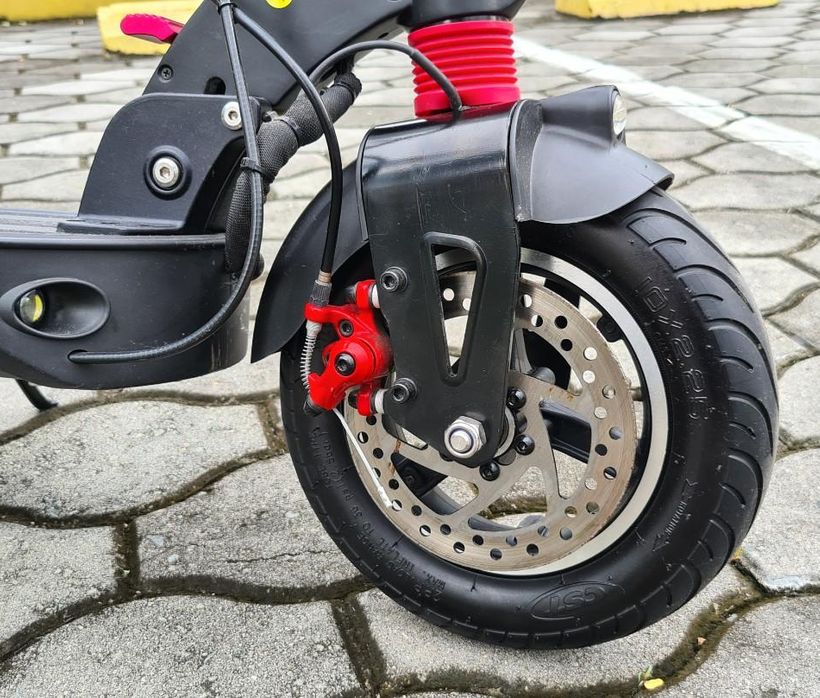
Of course, there is a hierarchy in the world of electric scooter brakes, and – while disc brakes are a solid addition to any scooter – they still pale to the power and efficacy of their hydraulic counterparts. So, if you’re set on bagging a scooter with the finest brakes in the Zero 10’s price class, you’re better off opting for either the Mantis Base or the EMOVE Cruiser.
That said, despite the Mantis and the Cruiser both coming decked out with semi-hydraulic disc brakes, it’s only the latter that beats the Zero 10 for stopping distance. Able to come to a stop in just 3.0 meters from 15 mph, the EMOVE Cruiser’s semi-hydraulic setup offers the best performance.
Plus, it’s worth mentioning that – like most scooters of its ilk – the Zero 10 sports a regenerative braking system. This augments the scooter’s dual mechanical disc brakes by feeding kinetic energy from the brakes (which would otherwise be wasted) back into the battery to help extend your battery life. You can customize the strength of this (or turn it off altogether) by tinkering with the P-settings on your scooter’s QS-S4 display.
Charge Time
The amount of time the Zero 10 takes to reach full charge can vary, but it’s typically around 8 hours, which – thanks to the larger capacity of its battery – is a little more than the charge time of the Zero 9.
You can cut this time in half by purchasing a fast charger, which will get you juiced up and back on the road in as little as 4 hours. However, I wouldn’t recommend relying on the fast charger all the time – it can have long-term implications for the health of your battery if overused.
Extra Features
QS-S4 Throttle Display for Customized Performance Configuration
Like many other scooters, the Zero 10 utilizes the standardized QS-S4 device to serve as both a display screen and finger throttle. This straightforward, user-friendly panel isn’t the most customizable on the market, but there’s a reason it’s used by brands like Kaabo, Apollo, Varla, and VSETT – it’s simple, intuitive, and pretty darn powerful to boot.
The QS-S4 has a small, backlit screen where you’ll be able to view your current speed, miles traveled (on your current ride, and all time), as well as its battery life and riding mode. All this info helps you keep tabs on your riding stats, and regulate your speed and acceleration to enjoy the maximum threshold of the 33 mile range.
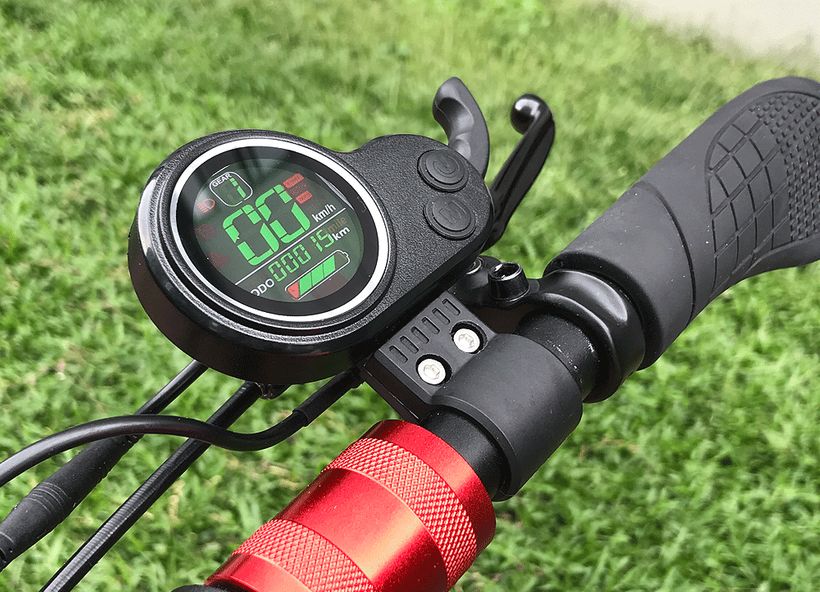
Beyond these basics, the QS-S4 offers another, more advanced level of features, in the form of ‘P-settings’. More casual riders can usually get by without fiddling with these, but – for those with the time, effort, and inclination to do so – getting to grips with these settings offers customizability benefits.
With the P-settings, you can adjust the strength of your regenerative braking system and acceleration, tinker with the auto turn-off function, and configure the brightness of the display. Each of these features helps to conserve your battery.
Ultimately, the QS-S4 will never be as slick as Dualtron’s EY3 display, or as striking as a custom-made display, such as the one you’ll see gracing the handlebars of the Apollo Phantom or NAMI Burn-e. But, the QS-S4 is user-friendly, a cinch to get the hang of, and – in the end – an ideal match for the Zero 10’s specs and capabilities.
Secret Feature: Hidden USB Port to Charge Your Mobile /Other Devices
It’s easy to miss this feature, but tucked away behind your QS-S4 display is a ‘hidden’ USB port. It’s tough to know exactly what this is meant for, because – while it is super handy for charging your electronic devices on the go – I wouldn’t recommend doing so if you’re invested in the long-term health of your scooter.
That’s because relying too much on this hidden USB port to juice up your smartphone or GoPro will take a toll on the health of your battery. This has implications not only on the number of miles you’ll be able to get out of your Zero 10 on the current ride but the longevity of the scooter’s battery over time. Plus, when you plug electronic accessories into your QS-S4, you risk overloading its circuits and causing permanent damage to the device.
My advice? Use it only in times of desperation.
Cruise Control
As we’re entitled to expect from a scooter of the Zero 10’s caliber, a cruise control function is included as standard. This allows you to maintain a constant speed while you’re out on the road, and avoid the strain on your finger that comes with keeping the throttle pressed down the whole time.
To activate cruise control, navigate to setting P6 on its QS-S4 display and switch the ‘0’ on the screen to a ‘1’. Then, once you’ve reached the speed you’re keen to maintain, the cruise control will kick in, and allow you to release your hold on the throttle while staying at a safe, relaxed cruising speed. To regain manual control of the scooter, simply give the brakes a little squeeze.
LED Lights (Featuring a Stem Strip and Mood Deck LEDs)
Sure – the Zero 10 may not sport the speed of the Mantis Base, the range of the EMOVE Cruiser, or the water-resistance of the Apollo Explore. There is one area, though, in which it outstrips this whole trio of rivals – in the glitz and glamor of its LED setup.
With a headlight, two front button lights, and responsive tail lights bookending the dual strips of deck-embedded LEDs, the Zero 10 stands out from the crowd. It also sports stem strip lighting which is exclusive to the Zero 9 and 10 models – you won’t see these lights on the more advanced 10X and 11X scooters in the line.
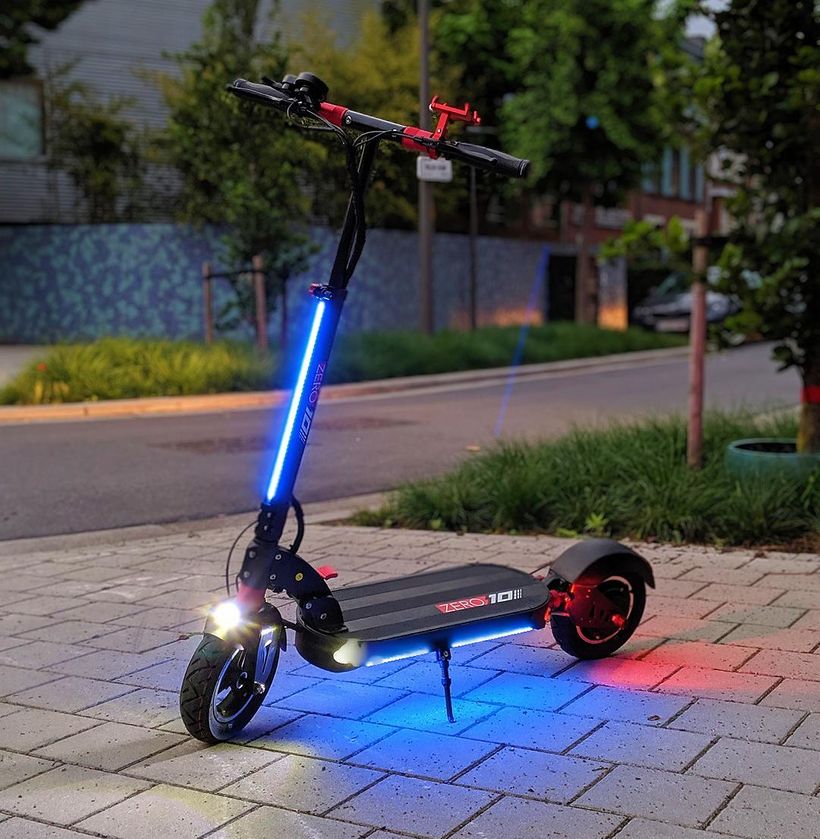
With all that swag lighting, you’ll have no problem being seen (and admired) by other traffic and pedestrians. The only visibility issue you might have, though, is your own – and for that, we can blame the Zero 10’s lackluster headlight. Poor headlights are, sadly, one of the most common design flaws on scooters and this one falls into much the same trap.
In part, that’s down to a lack of lumens, which means the headlight isn’t quite bright enough for night riding. However, the headlight’s poor performance is also a result of its placement, which – being located on the front fender, rather than higher up on the stem – limits its efficacy. With that said, you’ll need to shell out for an extra attachable headlight.
For a scooter with a brighter headlight, the EMOVE Cruiser is a great alternative and is available for the same price as the Zero 10.
Telescopic Stem for Adjustable Handlebar Height
As we saw earlier in our speed comparisons, the Zero 10 isn’t the fastest scooter on the market. But this isn’t always a drawback. There are some fantastic features – such as a telescopic stem, and foldable handlebars – that are impractical on speedier scooters, but just the ticket for scooters in the Zero 10’s ballpark.
A telescopic stem – so-called because of the way it contracts and extends in the manner of an old-fashioned telescope – allows you to customize the height of your scooter’s stem to fit your height, or fit the size of any of your friends or family members that may be taking it for a spin. A quick-release collar clamp lever helps secure the stem, and keep the height where you want it – so always make sure this mechanism is firmly fastened before you set out on a ride.
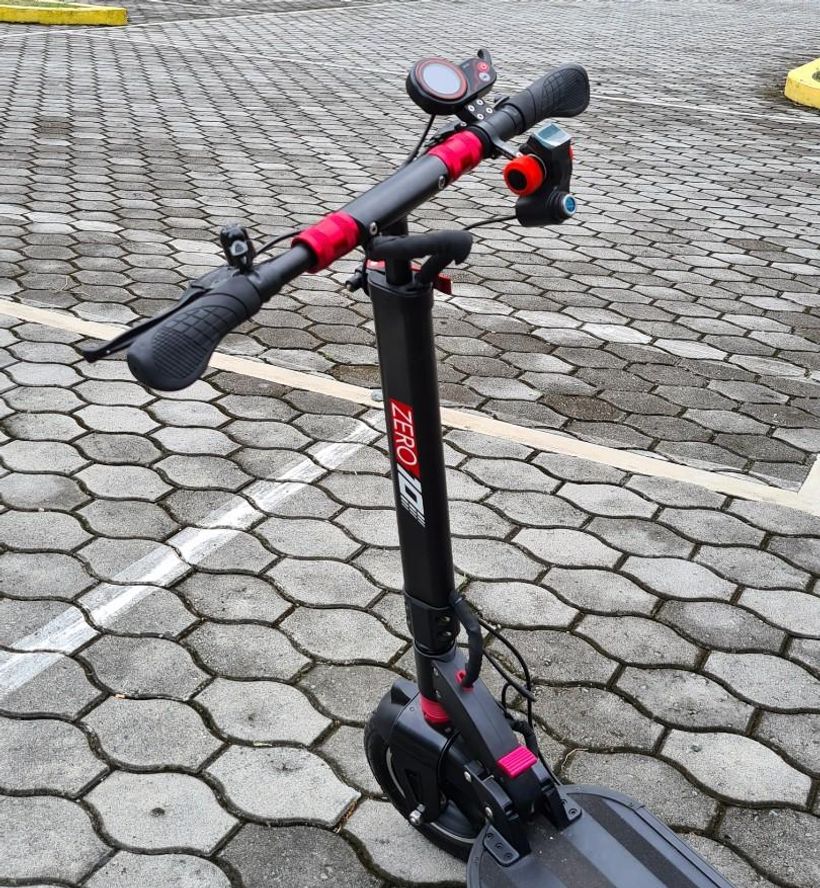
In the Zero 10’s case, the height of your handlebars can be anywhere between 29 and 39 inches – giving you a long, 10-inch range within which to operate. What’s more, the telescopic stem’s usefulness isn’t just restricted to catering to your comfort and posture while riding, but also comes in handy when it’s time to pack the scooter away into a small space.
That said, this feature isn’t without its issues. Like any scooters with moving parts (foldable handlebars, which I’ll unpack next, also fall into this category), the 10’s telescopic stem can make your scooter’s handlebars vulnerable to stem wobble. Though this shouldn’t be too much of an issue or safety hazard (especially considering the 10’s relatively limited top speed), it’s still a little irritating.
If you’d rather trade in the telescopic stem and foldable handlebars – and benefit from more speed and range while you’re at it – you should upgrade to the Mantis. This scooter cranks up all the 10’s specs but sacrifices the convenience of its portability-oriented features. It also weighs much more than the 10 – so if any kind of commuting is on your mind, you’re better off staying put.
Foldable Handlebars for Enhanced Portability
Much like the Zero 9 before it, the Zero 10’s handlebars fold – a neat value add that helps the scooter collapse down to fit the trunk of a car, or tuck away into a closet or small space at home. Moreover, these folding handlebars aren’t something that we see on the Zero line’s more premium models, such as the 10X and 11X – so if portability is a prime pain point for you, the 10 is the perfect pick.
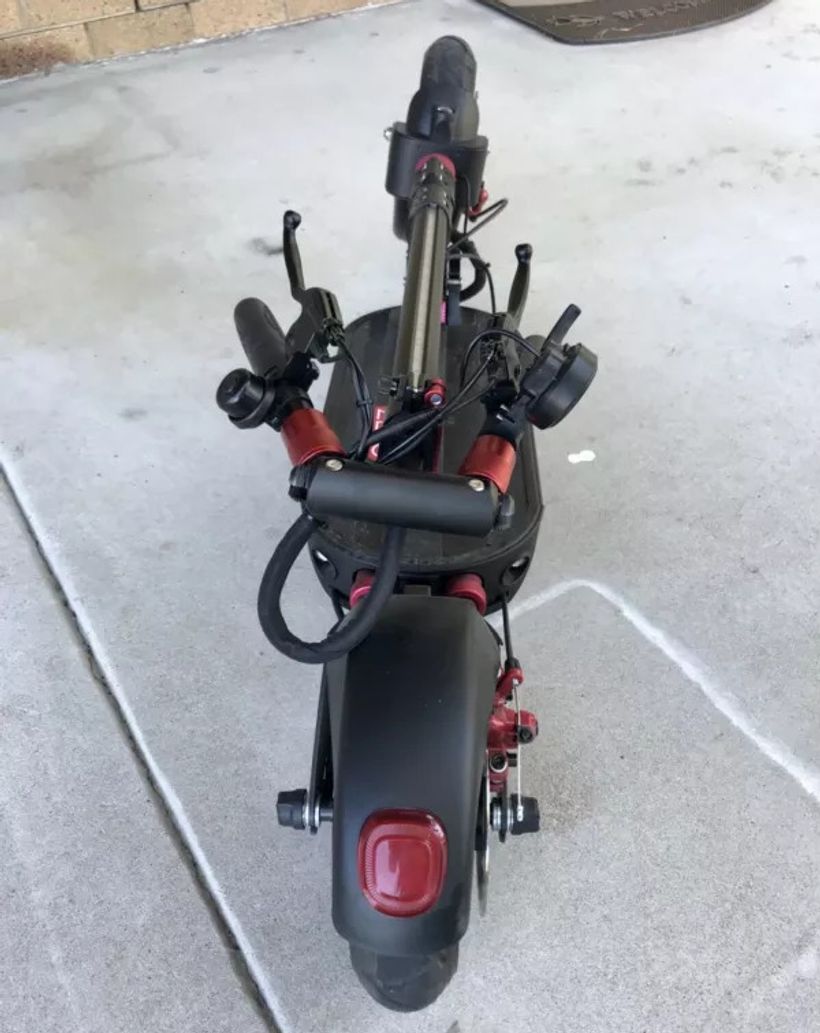
The Zero 10’s handlebars utilize a relatively basic folding screw mechanism, which has the benefit of being easy to use.
The flipside of this, though, is that the locking rings tend to loosen up over time, meaning you may experience a small amount of wobble in the handgrips. To avoid the chances of this compromising your ride quality, it’s best to tighten them before and after each ride.
Optional Seat Attachment
Not many scooters offer the option to sit down while riding, so the fact that the Zero 10 does is a huge plus. For just $95, you can bag an attachable seat, which is fully adjustable, so you can customize it to fit the height and posture of the rider.
Better still, hydraulic suspension is built into the seat post to buffer any residual vibrations from the scooter’s main suspension.
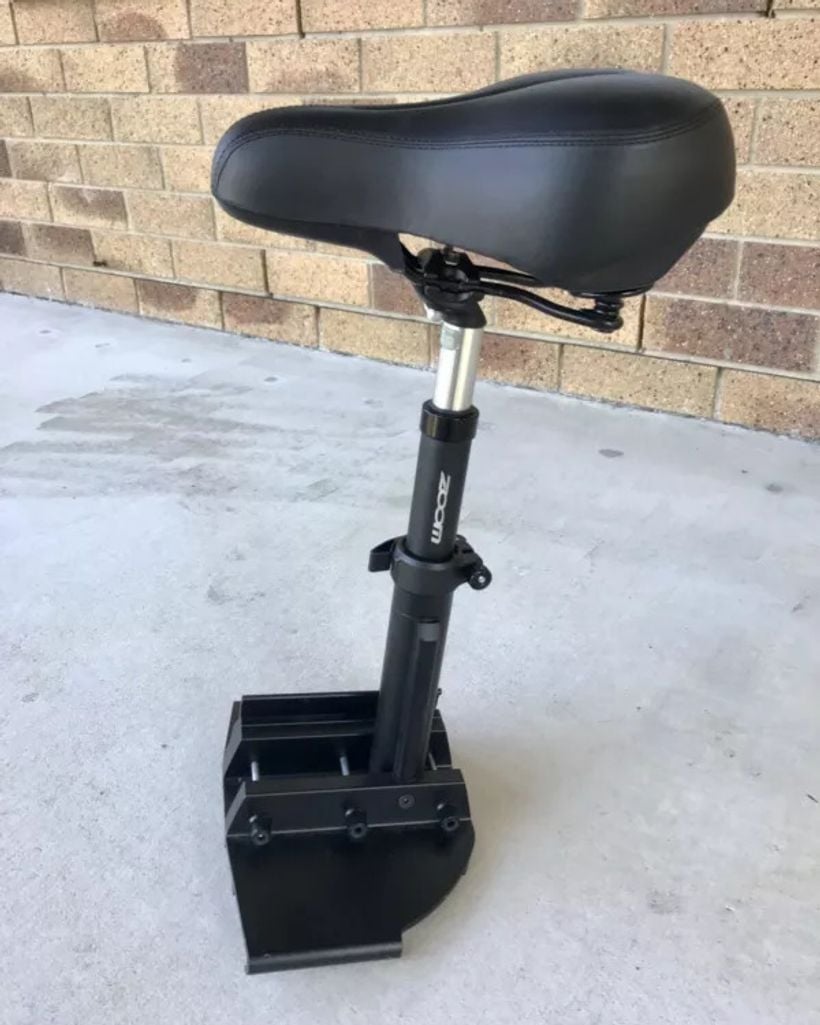
Installing the seat is simple, too. There are a few screws to take care of, but no drilling or DIY expertise is necessary whatsoever.
To browse similar scooters that also sport the option of a seat attachment, check out my reviews of the Apollo Explore and the EMOVE Cruiser for more info.
Specification: Zero 10 Review
| Brand | ||||||||||||
|---|---|---|---|---|---|---|---|---|---|---|---|---|
|
||||||||||||
| Type | ||||||||||||
|
||||||||||||
| Design | ||||||||||||
|
||||||||||||
| Performance | ||||||||||||
|
||||||||||||
| Extra Features | ||||||||||||
|
||||||||||||
Warranty & Post-Purchase Support
Warranty
The Zero 10 comes with a 12-month warranty when you make your purchase through REV Rides, Zero’s U.S. distributor. As is to be expected, this warranty doesn’t cover wear and tear, or any damage that’s deemed to be a result of your misuse, neglect, or failure to adequately maintain your scooter.
The warranty also excludes any environmental damage (such as that incurred in conditions of rain – remember, the scooter’s not water-resistant), as well as that caused by any unauthorized modifications. Likewise, any damage to the scooter that’s deemed to be your fault – such as that arising from an accident or collision – won’t be covered by the warranty policy.
REV Rides’ warranty (unlike more forgiving policies, such as that offered by FluidFreeRide) also doesn’t cover the costs of labor, which means you may be liable for any charges involving the repair of your scooter, or the replacement of its parts.
Ultimately – while it’s not a terrible policy – it isn’t the most generous. It fails to match the high standard set by the warranty of the Apollo Explore (which, as you’ll remember, is the 10’s long-lost twin). The Explore matches the 12-month cover for manufacturer defects, but also offers a further year of protection for repairs where you’ll only be invoiced for the costs of repair – without any labor or service fees piling up on top.
That said, the Zero 10’s warranty can be extended beyond its initial year-long term – you’ll just have to dig into your pockets. Via third-party product protection company Extend, you’ll have the option to lengthen your warranty for the following periods:
- One year: $249
- Two years: $369
- Three years: $489
These extensions seem a little expensive, sure – particularly when you consider that the extra $249 could buy you the Mantis Base, a scooter far superior to the Zero 10. However, if you’re someone that likes an extra layer of security when you make a high-ticket purchase, I recommend biting the bullet and opting for an extra year or two of additional coverage.
Post-Purchase Support
Post-purchase help and support is available via REV Rides across all the major channels. You can get in touch with the team via email (contactus@revrides.com), or take advantage of the online form on their website to submit a support request.
Alternatively, you can access phone-based support by dialing 1-360-888-7433 between the hours of 8 am and 4 pm PST, Monday to Friday. The REV Rides customer support team is a reflection of its CEO, Nathan Pust – who I was fortunate enough to jump on a call with earlier this year and get firsthand experience of the company’s commitment to customer service and quality control.
Support with your Zero 10 can also be accessed via REV Rides’ Facebook and Twitter channels, though the company’s social presence is a little lighter than some of the other top electric scooter retailers.
Still, REV Rides’ YouTube account is excellent. On top of a wide range of explanatory videos designed to get you to grips with the Zero 10’s parts and features (such as its ingenious QS-S4 display and finger throttle), the channel boasts guides to changing the scooter’s tires and tubes, as well as folding its handlebars, aligning its steering, and adjusting its brakes.
Specification: Zero 10 Review
| Brand | ||||||||||||
|---|---|---|---|---|---|---|---|---|---|---|---|---|
|
||||||||||||
| Type | ||||||||||||
|
||||||||||||
| Design | ||||||||||||
|
||||||||||||
| Performance | ||||||||||||
|
||||||||||||
| Extra Features | ||||||||||||
|
||||||||||||



